The last blast of winter seems to have taken place and the crocuses are blooming. Snowdrops drift across the pet graveyard under the black walnut tree like snowy remnants left behind after the last thaw.

Last week C. and I made a trip to town for supplies. The road to town was finally clear of snow. We were out of milk, coffee, oats and other essentials. It was past time to stock up on groceries. I was eager to find one particular item that had been on my list for the past couple of months: the elusive Seville orange.
This is the time of year for making marmalade. During January and February I keep a sharp lookout for the rare and wonderful Seville oranges, the bitter fruit used to make the best tasting orange marmalade. They are normally found in one or two grocery stores in town during the short Seville orange season.
Sour oranges were first brought by traders from China to the Iberian Peninsula and the Mediterranean basin around the 10th century. By the 12th century, Spaniards in the region around Seville were cultivating the bitter oranges that would become known by the name of that Spanish town. Much later, these oranges would be introduced to the New World. Eventually they would be used as root stock for the more popular sweet, eating oranges that are grown commercially today. These days, on this continent, Seville oranges in our markets are most often grown in California.
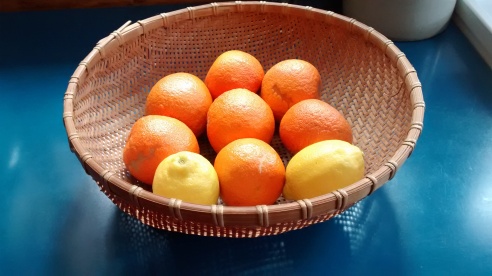
Making orange marmalade is a British thing. There is compelling evidence that bitter orange marmalade was being made in English kitchens in the 16th century during the reign of the Tudors. Commercial Seville orange marmalade was first produced in Scotland around 1700 when a Spanish ship carrying Seville oranges sought refuge from a storm at the port of Dundee. There the cargo of oranges were sold off to a local merchant by the name of James Keiller. The story goes that his wife preserved the fruit by boiling the oranges up with a quantity of sugar. The rest is history!
My English grandmother was a perpetual marmalade maker who produced vats of the delicious preserve during the latter half of her 94 years on this earth. She sold pint jars of marmalade for twelve dollars a piece to a string of faithful customers near her home in once rural southern Ontario. It was a good way to pass the days at the end of the long winters there, before the springtime garden would call her outdoors.
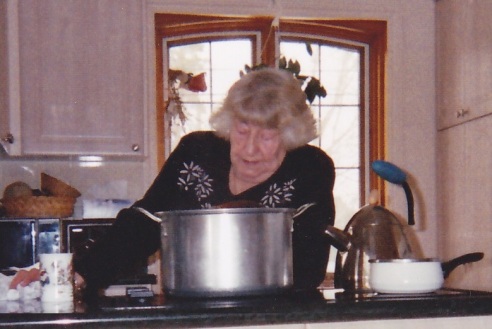
Visiting my grandmother one February (she was 90 at the time) I was recruited to help make the marmalade. I jotted down her recipe, recited to me as she stirred sugar into the fragrant fruit mixture simmering on the stove. It was a memorable occasion, as preparing food with a loved one can be. Family tradition is cultivated during moments like these, manifested in recipes passed down through generations of family cooks.
Once, in our own west coast kitchen, my youngest daughter and I were cutting up oranges for our annual batch of marmalade when I had an overwhelming urge give my grandmother a call. To my surprise my Uncle T. answered the phone in my grandmother’s Ontario kitchen where he was visiting. He and my grandmother were simultaneously preparing the annual batch of marmalade, more than 3,000 kilometers away! All four of us were connected in that instant by a simple family recipe for orange marmalade.
Last week in town it took some time to track down any Seville oranges at all; first one produce department, then the next were sold out. No more marmalade oranges would be available until next year. I was severely disappointed until C. suggested that I call the produce manager at the last possible source of marmalade oranges, Discovery Foods, just up the hill from downtown. It made my day when the young fellow told me he had precisely twenty-four Seville oranges left! I felt like I had won the lottery! I was told that each year a box of Seville oranges is ordered for the two or three marmalade makers that come searching for them. I was the third.
The oranges were pure gold to me; juicy, large and thick-skinned. Because these were the last oranges in the bottom of the box and he wanted to get rid of them before they spoiled, the grocer charged me just fifty cents a pound. I walked out of the store with the last two dozen Seville oranges (possibly on the entire north island) all for a measly five dollars. I was thrilled!
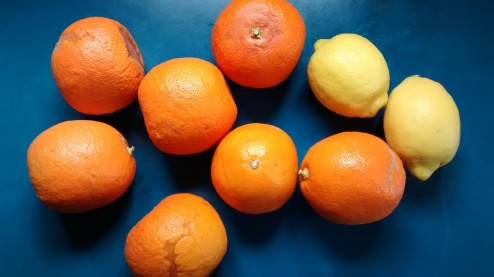
My grandmother’s recipe for orange marmalade is a simple one calling for eight Seville oranges as well as a couple of lemons, and a lot of sugar. Nobody said marmalade was a particularly healthy condiment! A single batch yields approximately twenty half pint jars of lovely golden marmalade, more than a year’s supply for our household. So, what to do with the extra oranges that I had been so fortunate to come across?
An island friend, recently experimenting with marmalade making, had not been able to find any Seville oranges herself. At book club last Sunday, I handed over a bag containing enough fruit for a batch of my grandmother’s marmalade. That left me with eight more lovely looking Seville oranges. I popped these into a Ziplock bag and into the freezer to be used at a later date, either for more marmalade, or experimentally in other recipes. I have read that the rind, finely grated, makes a good seasoning for fish or meat dishes, or that the juice can be used to make an interesting mayonnaise. The peel of the Seville orange is reported to make the best candied peel, useful for Christmas baking.
The best way to consume the bitter Seville orange, in my experience, is after its transformation into a delicious preserve, one spoonful at a time, like a dollop of sunshine, on a biscuit or a piece of buttered toast, alongside a nice cup of tea.
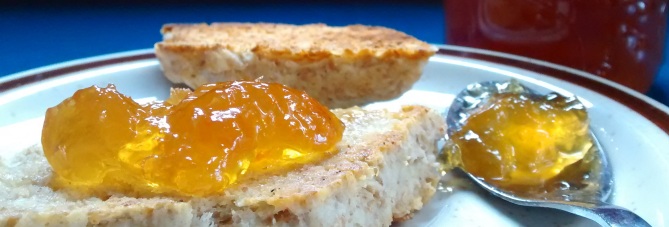
The weather these past few days has been sublime; clear and sunny, but still cool. My attention has been outdoors, in the apple orchard where I have been doing a bit of light pruning. Unbelievably though, there is more snow in the forecast! It will be perfect weather to come inside and make some marmalade in my cozy kitchen. Today I will begin the two day long process of turning those bitter golden fruits into a pot of luscious orange marmalade just as my grandmother used to do, and her mother and grandmother before her.
Cissy’s Orange Marmalade 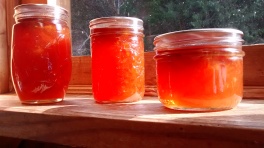
8 Seville oranges
2 lemons
16 cups water
16 cups sugar
This recipe makes approximately 20 cups (half pints) of marmalade. If you don’t want this much, you can cut the recipe in half.
Wash fruit and cut in half, squeeze out the juice and put it in a large non-reactive (stainless steel, glass or ceramic) bowl. Remove the pips as you go and put them in a small, stainless saucepan with 1 cup of water. Boil for 5 minutes, cool, strain and reserve. You will need this later; it contains the pectin required to help thicken the marmalade. Discard the pips. Using a sharp knife, cut the remaining orange and lemon halves, pith and membrane included, into fine slivers. Add the remaining 15 cups of water, cover with a clean tea towel and set aside in a cool pantry, or the fridge, to soak for 24 hours. This will help soften the peel.
Add the strained pip liquid to the fruit mixture. In a large stainless steel pot bring the fruit and water mixture to a rolling boil. Adjust the heat if necessary and continue to boil for an hour. This will reduce the amount of liquid, helping to thicken the finished product. If your jam making pot is not large enough to comfortably contain all the fruit mixture at once, you may divide the fruit mixture in half and cook it in two batches.
Gradually add the 16 cups of sugar, if cooking in one batch. If dividing the fruit for cooking, then also divide the sugar. Using a long handled spoon, stir gently until the sugar has dissolved. Continue cooking, stirring occasionally, until the mixture returns to a rolling boil. Adjust the heat if necessary to allow the mixture to cook at a fairly rapid boil without boiling over, or scorching, until thick, approximately 40-60 minutes if cooking in one batch.
The best way to tell if your marmalade is set correctly is to use a candy thermometer. The correct set will be reached at a temperature of 220* F (105 *C) at sea level. For each 1000 feet of altitude, subtract 2*F.
Skim any foam off the top with a metal spoon and bottle your marmalade as follows.
You will have prepared your pint or half-pint jars, lids and screw bands by washing in hot soapy water, rinsing thoroughly and sterilizing them in a covered pot with a rack and about 4 inches of water, boiling for ten minutes. Carefully fill each hot jar with hot marmalade using a widemouth preserving funnel and a heatproof ladle or measuring cup. Be careful not to scald yourself. Wipe the rims clean with a damp cloth and apply the hot, sterile lids and bands. Jars of preserves should be processed for ten minutes in a hot water bath . Instructions may be found online, in a good all purpose cookery book, or in my post about making chutney, called “Pass The Chutney Please”.
After processing, place the sealed jars on a folded tea towel on the counter, away from drafts, to cool. Wipe the jars clean, label and store on a pantry shelf until ready to use.
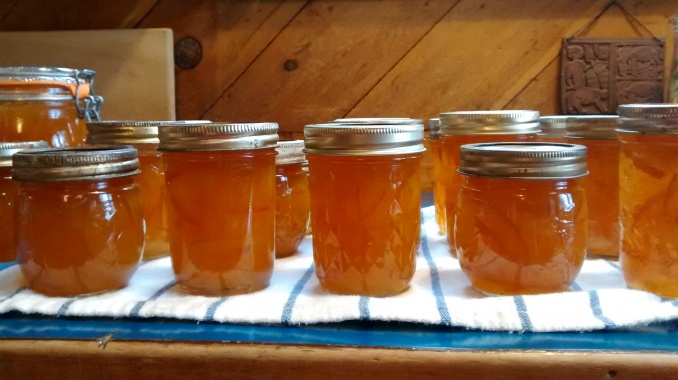










I made marmalade for the first time this year. I’ve never had home canned marmalade so was surprised at how bitter mine turned out. There were some differences in the recipe I used from yours. First, I did not know about using Seville oranges. Next, I did not squeeze out the juice before cutting up the rind and pith and letting it sit in water for 24 hours. I didn’t see in the recipe, but I assume you did not use the juice in the jam. I put the seeds in cheesecloth and cooked them in the pot with the water and slivered oranges and lemons until everything was soft. It jelled nicely and looked pretty. But should it have tasted so bitter, or do the Seville oranges make the difference? – Margy
LikeLike
Yes, you do use the juice, I will check, but I think I did mention to add the juice to the bowl along with the sliced peels and water. It is just a lot messier if you don’t first remove the juice, but doesn’t really matter. You need to use the entire fruit, chopped, or ground or sliced up. Seville oranges are bitter oranges, this is the point, though less expensive commercial orange marmalade is not so bitter. Tasteless in my opinion. Thanks for your comment. Happy cooking! C.L.
LikeLike
I have a couple of cans of MamaMade that have sat in my pantry for a decade or so. These cans contain something orangey and apparently are a shortcut for making marmalade. Despite this being our family ‘recipe’, passed on to me by my mother when she stopped making MamaMade, I haven’t actually read the label. One of these days…
LikeLike
Thanks Sally, Nice and interesting comment! My Dad uses that stuff with success. Good way to avoid all the knife-work, and apparently the finished product is not too bad. You won’t have to worry about missing the window of opportunity for fresh Seville oranges. Sounds as if the MamaMade has an indefinite shelf life too so you won’t have to worry about it if you don’t get around to using it for another couple of decades!! Anyway, you don’t need any “sunshine” in a jar, down south as you are! Don’t rush back, it is freezing and more snow in the forecast!
LikeLike
My recipe, from Dad’s English cousins, is almost the same. 3# Seville oranges, juice of two lemons, 6# sugar. I haven’t yet found the Sevilles down here.
LikeLike
Hi Gill, Thanks for your comment! Yes, it seems most recipes are similar, nice and simple. You may have missed the season for Sevilles, though Robin spotted a mountain of them at the Thrifty’s store in Courtenay a while ago; they must have a lot of marmalade-makers down there; lots of ex-pat British retirees I suspect! Cheers! XX
LikeLike
Hi again Gill, I just cooked up my batch of marmalade. Figured I must have had just over three pounds of fruit, and used 16 cups, or 8 pounds of sugar. That is a lot of white death!! Next time I am going to try your Dad’s English cousin’s method, which uses 2 pounds less sugar. Thanks for the tip! This is what the “family” recipe thing is all about! X C.
LikeLike